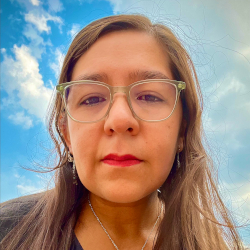
Nidia Olvera Hernández is a Postdoctoral Researcher at Radboud University and a 2024-2025 Consortium Research Fellow.
The project “Traditional Uses of Mexican Psychoactive Plants: From the Creation of a National Pharmacopeia to Ethnographical Collections, 1900–1957” seeks to investigate how scientific approaches to the study of traditional uses of Mexican natural drugs—mainly peyote (Lophophora williamsii), psilocybin mushrooms (Psilocybe spp.), and other psychoactive species (Rivea corymbosa, Ipomoea violacea, and Datura stramonium)—were transformed during the first half of the 20th century. This research focuses on scientific studies in botany, medicine, and anthropology carried out in Mexico, and how these investigations were related to scientists from the Global North and with research developed within Mexico.
This project is part of a larger interdisciplinary project titled: “Poison, Medicine or Magic Potion? Shifting Perspectives on Drugs in Latin America (1820–2020) ” at Radboud University, which analyzes the changing perceptions of psychoactive plants from a critical and interdisciplinary perspective. The analysis will be conducted through extensive research in historical archives, museums, and other repositories. Various collections in Mexico help reconstruct the histories of these plants; however, for this project, it is essential to also review collections held in institutions outside of Mexico. These international collections contain valuable information about historical Mexican publications, demonstrate the connections between Mexican scientists and researchers from other parts of the world, and offer insights into foreign research on the traditional uses of these psychoactive species.
With the generous support of the Consortium for History of Science, Technology and Medicine, I visited three additional institutions for research: the Wellcome Collection, the Botany Libraries at Harvard University, and the Smithsonian Collections, all of which hold valuable archival materials related to the history of psychoactive plant studies and their scientific reception.
At the Wellcome Collection in London, I examined rare books on Mexican botany and medicine from the 19th and early 20th centuries. This collection holds a wide variety of historical materials related to the history of health and herbal medicine in Latin America and beyond. Pharmacopeias from different countries in the region reveal how psychoactive plants were disseminated and transformed into “official remedies.” Additionally, this visit allowed me to research the work of pioneering European scientists—such as Heinrich Klüver, Lewis Lewin, and Blas Pablo Reko—who studied psychoactive species. Their contributions were fundamental in shaping early scientific discourse on these plants and in fostering transnational interest in their ethnobotanical and pharmacological properties, which helped me better understand how international interest in these drugs developed over time.
Next, I visited the Harvard University Herbaria in Cambridge, Massachusetts, where I consulted the Richard Evans Schultes Papers. This collection contains extensive correspondence, field notes, and photographic material from this prominent ethnobotanist who conducted pioneering research on psychoactive plants. This visit also gave me access to the Tina and R. Gordon Wasson Ethnomycological Collection Archives—a vast repository that includes documentation of Wasson’s studies on psilocybin mushrooms and other psychoactive species from Mexico, such as peyote, ololiuqui, and Salvia divinorum. Wasson’s materials not only provide valuable insights into the traditional uses of these species in Indigenous contexts, but also reveal how scientific interest contributed to the commodification and medicalization of “magic mushrooms” and other sacred plants—species that have long been, and continue to be, revered by Indigenous communities
Finally, I traveled to Washington, D.C., to conduct research at the Smithsonian Collections. Particularly, I visited the Joseph F. Cullman Library, which houses the Smithsonian’s collection of rare books in anthropology and the natural sciences. There, I consulted some of the earliest botanical and anthropological studies written about peyote in the United States. Additionally, I visited the National Anthropological Archives, where I examined the papers of James Mooney, Weston La Barre, and Aleš Hrdlička—three of the most influential ethnologists who researched the traditional uses of the peyote cactus among both Mexican and North American Indigenous communities. These archival materials offer valuable insight into how early ethnographers documented Indigenous knowledge and ceremonial practices, often framing them through the scientific and cultural biases of their time. This part of the research was essential to understanding the construction of scientific narratives around peyote and its shifting place between medicine, ritual, and regulation in the 20th century.
These visits further allowed for the development of a more global perspective on the scientific study of psychoactive plants, as well as a clearer understanding of the transnational connections between researchers in Mexico, the United States, and Europe. This broader approach is essential for tracing how knowledge about these natural species circulated across borders. Thanks to the support of the Consortium for History of Science, Technology and Medicine, and the assistance of the collections staff at the three institutions visited, this research was made possible. Access to these archives proved immensely beneficial to the development of the project. Through the consultation of rich and varied sources, it was possible to gain new insights into the ways in which psychoactive plants were studied, classified, and understood within different scientific traditions during the 20th century. Archivists, librarians, and staff members at each institution were generous with their time, knowledge, and support, greatly facilitating the research process. The community of fellows at the Consortium also provided valuable feedback that helped refine the scope of the work, and offered opportunities to discover new collections and relevant bibliography on the topic.